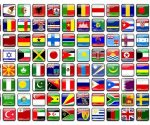Multilingual Search Engine Optimisation (SEO) involves optimising your website and its content so that search engines can identify the languages you’re using and the countries you’re targeting.
Incorporating multilingual SEO as part of your localisation strategy is essential to paving the way for global success.
Get it right and revenue streams will quickly spread through new markets. Get it wrong and you’ll lose out on visibility in wider, international markets and risk putting marketing budget to waste.
Ultimately, no matter which market you’re aiming for, content must be accessible, searchable, targeted and above all readable.
We all know that the online marketplace is a highly competitive environment, with over 200 million active websites on the web today. Visibility is imperative for success, from a local to global scale.
In order to effectively compete on the web and to be truly global, you need to make sure you’re SEO and PPC (pay per click) strategies are optimised to appear positively in search results within every language and market you’re targeting.
Let’s take a closer look at the reasons why multilingual SEO needs to be woven into the localisation process:
Web Localisation and SEO Overlap
These days, a website’s development and optimisation is very much part of the overall marketing process –as is localisation.
These practices significantly overlap now, making it hard to differentiate them and this is just the case for multilingual SEO and web localisation. Take a look at the list below concerning localisation tasks and see how many of them overlap with SEO:
- Audience research
- Choosing domain and URL structure
- Choosing web hosting
- Creating language selector
- Using UFT-8 character set (HTML)
- Optimising/localising code for maintenance
- Confirming language for every version of site (HTML)
- Optimising titles and meta data for every language (HTML)
- Localising visual content
- Optimising visuals for every language – eg: file names, alt descriptions, etc. (HTML)
- Localising measurements, currencies, dates, times, etc.
- Localising landing pages
- Creating multilingual content
While this isn’t a complete website localisation checklist, you can see that each of one of those tasks can be acknowledged as SEO. However, they are not the same thing –it’s a more complex relationship than that.
As with most things in modern marketing, the overlap between different practices and strategies means you can’t involve one without the other. So don’t expect to get the best out of multilingual SEO without localisation being a crucial part of your marketing campaign –or vice versa.
A New Market Means New Keywords

SEO is all about visibility and getting your site on that glorious first page of search results for your keywords or key phrases. There are several factors that influence organic search and rankings. On-page SEO, however, will always be the cornerstone of the practice.
Many businesses simply translate their original keywords in the hopes of ranking well in new markets. This strategy is problematic because it doesn’t take into consideration the search volume in different markets or country-specific keywords that can have high search volume but no equivalent terminology in the original language.
To connect with the right audience and optimise your website for multilingual SEO, its content, and keywords must reflect the linguistic and cultural differences of your global audience within their local markets.
Here is where you need to research the keywords used locally.
An initial keyword search enables you to identify the top countries, markets, and languages bringing in maximum traffic to your site.
While you’re entering a new market, prioritise markets with a high/medium organic search visibility, above-quality conversions, and positive trend.
Markets with low organic search visibility and traffic, on the other hand, are not to be left aside. If there isn’t enough organic search volume for them, you’ll need more time and resources to achieve the desired search visibility.
This initial research helps in verifying the starting point and the growth potential for each global market, all whilst allowing you to prioritise and create your targets.
Lastly, collaborating with native linguists and translators for your localisation strategy will also help you in identifying the right keywords for your new markets.
Your New Market Might Not Be into Google
With over 90% market share, Google rules the search engine landscape in most of the top GDP nations worldwide, including Germany, Spain, Mexico, India, Italy, Australia, and Brazil.
Yet to enter new markets, you must expand your SEO strategy beyond Google. Once you have targeted more markets to tap into, check the top search engines in each one of these markets.
In China, for instance, Google makes up a mere 1.5% of market share with search engine Baidu dominating at 70%. In fact, Google takes 4th place after search engines Shenma, Haosou, and Sogou. Yahoo! also continues to showcase a strong presence in Japan.
Naver is the second most popular search engine in South Korea, with a 28% market share. Over one in four searches take place on this search engine, with that figure rising, it is definitely one that you need to consider if you plan on entering the Korean market.
If Eastern Europe is an ideal market for your business, take note of Yandex, which is the most popular search engine in Russia, although Google places 2nd with a 45% search market share.
While Google remains the search engine giant, it’s easy to see that there are some significant differences in search preferences and habits across the globe. It’s not just about cracking Google, looking into other search engines is key for both your multilingual SEO and localisation strategies.
Search Engine Marketing (SEM) and localisation no longer exist in two separate spheres. Businesses looking to enter new markets or operate more efficiently in markets they’re already in are realising that localising content and utilising multilingual SEO is becoming a necessity. Such practices via experts represent the future of multilingual online marketing.
Have you been integrating your SEO and localisation strategies? Let us know in the comments!
If you want to venture into new markets, our team not only creates unique content that engages the reader but we also help you obtain a higher chance of climbing those rankings. Get in touch with us to learn more.






